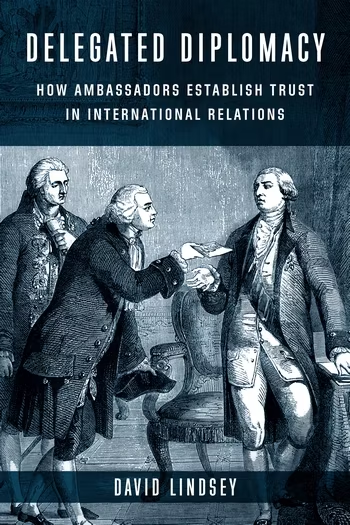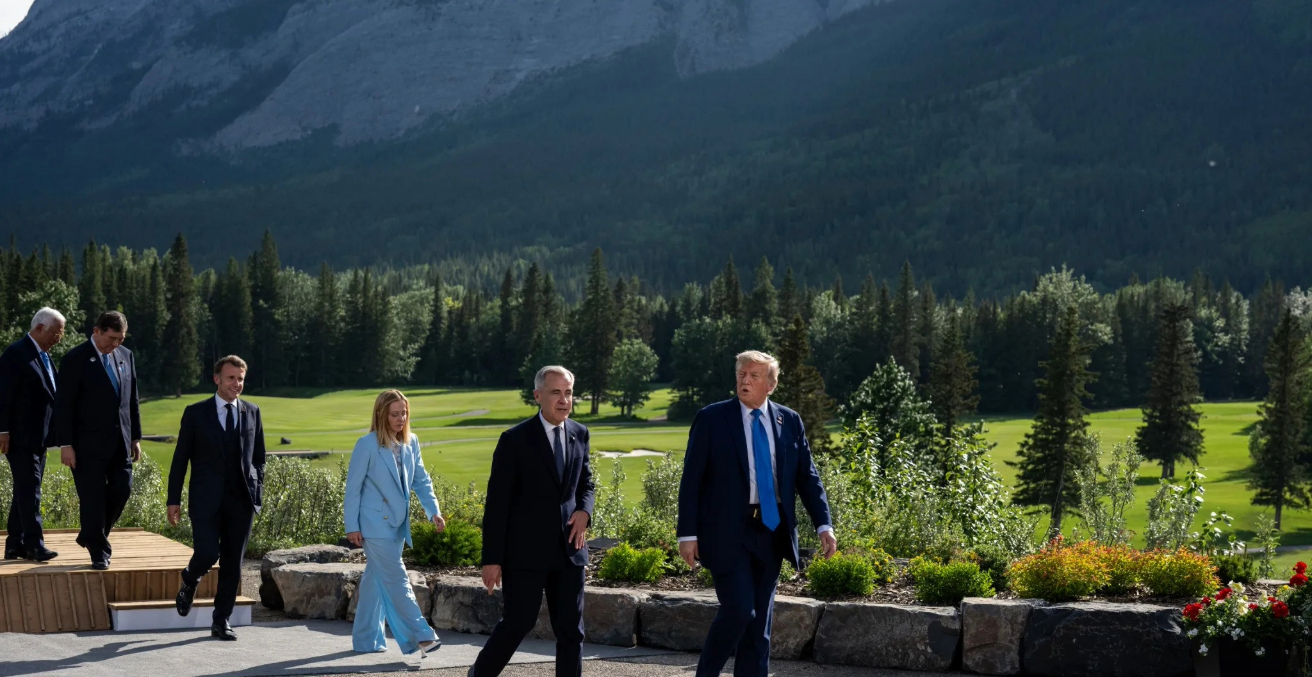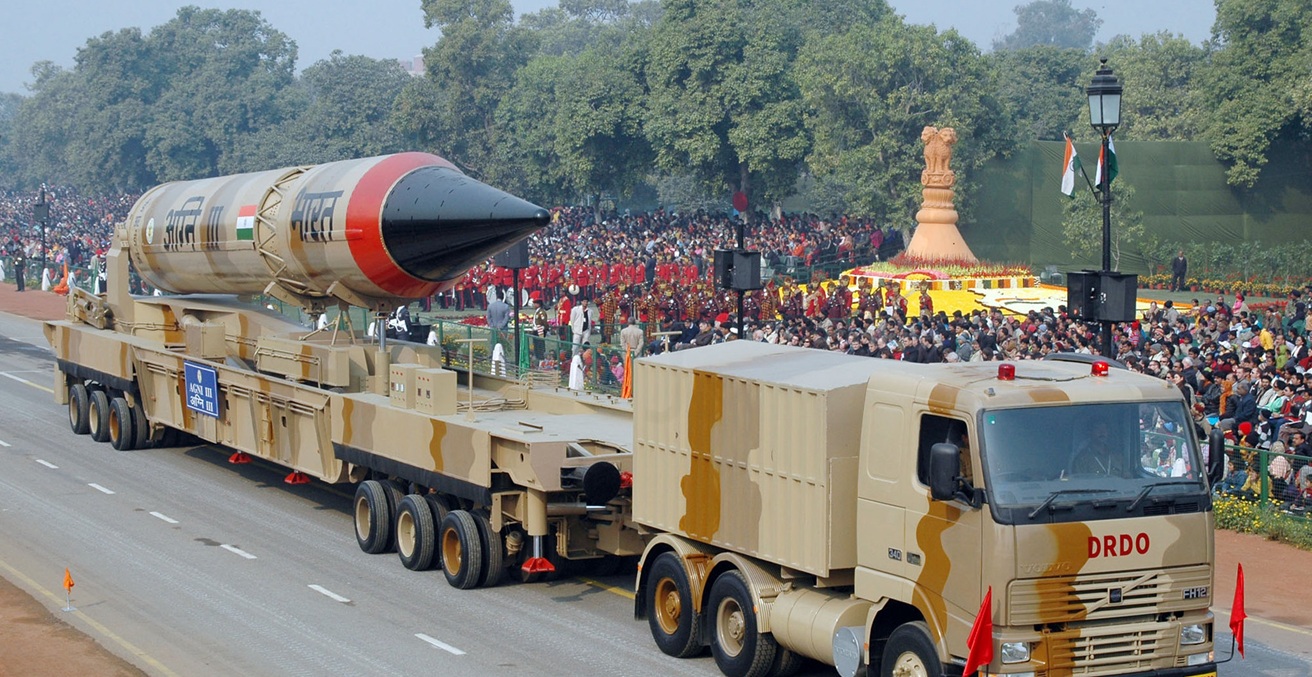This week in Australian foreign affairs: SSN-AUKUS announcement, Albanese attends Australia-India Annual Leaders’ Summit in New Delhi, Don Farrell meets with his Indian counterpart, Albanese travels to Fiji, support for Vanuatu following cyclones, and more.
On 14 March, Prime Minister Anthony Albanese, alongside President of the United States Joe Biden and Prime Minister of the United Kingdom Rishi Sunak, jointly announced the next stage of the AUKUS security partnership, SSN-AUKUS, in San Diego. The leaders described SSN-AUKUS as “a trilaterally-developed submarine based on the United Kingdom’s next-generation design that incorporates technology from all three nations, including cutting edge U.S. submarine technologies.” It will follow a phased approach, beginning in 2023, with “Australian military and civilian personnel … embed[ding] with the U.S. Navy, the Royal Navy, and in the United States and United Kingdom submarine industrial bases to accelerate the training of Australian personnel.” Then, “as early as 2027, the United States and United Kingdom plan to begin forward rotations of SSNs to Australia to accelerate the development of the Australian naval personnel, workforce, infrastructure and regulatory system necessary to establish a sovereign SSN capability.” In the “early 2030s, pending Congressional approval, the United States intends to sell Australia three Virginia class submarines, with the potential to sell up to two more if needed,” which will “systematically grow Australia’s sovereign SSN capability and support capacity.” The final step is that “in the late 2030s, the United Kingdom will deliver its first SSN-AUKUS to the Royal Navy” and “Australia will deliver the first SSN-AUKUS built in Australia to the Royal Australian navy in the early 2040s.” The leaders further noted that the plan “is designed to support Australia’s development of the infrastructure, technical capabilities, industry and human capital necessary to produce, maintain, operate, and steward a sovereign fleet of conventionally-armed, nuclear-powered submarines” and that “Australia is fully committed to responsible stewardship of naval nuclear propulsion technology”, including “the highest nuclear non-proliferation standard.”
In a speech following the SSN-AUKUS announcement, Albanese referred to the announcement as the beginning of “a new chapter … between our nation, the United States and the United Kingdom.” He noted that “our AUKUS partnership is not just about the US and UK sharing their most advanced submarine capability with Australia, it’s also about drawing and building on the expertise within our three nations, so that we can achieve things greater than the sum of our parts.” He referred to the partnership as a “genuine trilateral undertaking” and that “all three nations stand ready to contribute and all three nations stand ready to benefit.” Albanese emphasised that “our historic AUKUS partnership speaks to our collective and ongoing determination to defend those values and secure that future – today, in the years ahead and for generations to come.”
Albanese issued a media release with Deputy Prime Minister and Minister for Defence Richard Marles on 14 March noting that the AUKUS announcement about Australia’s acquisition of nuclear powered-submarines is “the single biggest investment in our defence capability in our history and represents a transformational moment for our nation, our Defence Force and our economy.” They also stated that the agreement will “strengthen Australia’s national security and contribute to regional stability in response to unprecedented strategic challenges”, “build a future made in Australia, by Australians, with record investments in defence, skills, jobs and infrastructure”, and “deliver a superior capability after a decade of inaction and mismanagement.” Albanese and Marles reflected on the phased approach as “deliver[ing] on the commitments of the Albanese Government and provides significant, long-term strategic benefits for all three countries.” They noted that this approach “will result in $6 billion invested in Australia’s industrial capability and workforce over the next four years, creating around 20,000 direct jobs over the next 30 years” and that “this whole of nation effort also presents a whole of nation opportunity; for new jobs, new industries, and new expertise in science, technology, and cyber.” Albanese and Marles announced that the approach “will see $2 billion in expected investment into South Australia, and a further $1 billion in Western Australia” and that “this commitment from the Australian Government will require funding for the phased approach to amount to around 0.15 per cent of GDP per year, averaged over the life of the program.” They also reaffirmed Australia’s commitment to “setting the highest nuclear non-proliferation standard for Australia’s acquisition of SSNs, in continued close cooperation with the International Atomic Energy Agency.”
On 14 March, Albanese, Marles, and Minister for Defence Industry and Minister for International Development and the Pacific Pat Conroy issued a statement about the AUKUS Submarine Workforce and Industry Strategy, which is being developed “to support delivery of advanced conventionally-armed nuclear-powered submarines to the Australian Defence Force.” They also noted that the program “will be the most transformative industrial endeavour in Australian history – exceeding in scale, complexity and economic significance the creation of an Australian automotive manufacturing sector and the construction of the Snowy Scheme in the post-war decades.” Albanese, Marles and Conroy noted that it will create “around 20,000 direct jobs over the next 30 years across industry, the Australian Defence Force and the Australian Public Service including trades workers, operators, technicians, engineers, scientists, submariners and project managers” and that this will include “up to 8,500 direct jobs in the industrial workforce.” In addition, they stated that “Australia’s scientific, education and training institutions will also play a central role” and that “Australians have already commenced training and working on UK and US nuclear-powered submarines and in UK and US facilities.” The goals of the AUKUS Submarine Workforce and Industry Strategy are to “attract, recruit, develop, qualify and retain a highly-skilled trades, technical, scientific and engineering workforce”, “invest in new infrastructure for sustaining and building nuclear-powered submarines in Australia”, and “support and build the capabilities of Australia’s world-leading defence industry.” The Strategy “will be finalised and implemented in consultation with our trilateral partners and state and territory governments, industry and unions” and “will complement the Albanese Government’s wider agenda to revitalise Australian manufacturing, ensuring we are a country that makes things – including identifying defence capability as a priority funding area for the $15 billion National Reconstruction Fund.”
Marles, Conroy, Minister for Foreign Affairs Penny Wong, Minister for Skills and Training Brendan O’Connor, Minister for Education Jason Clare, and Premier of South Australia Peter Malinauskas jointly announced the signing of a Submarine Cooperation Agreement on 15 March, which outlined the Albanese and Malinauskas Governments’ commitment to “supporting the construction of Australia’s next-generation conventionally-armed, nuclear-powered submarines in Adelaide.” They noted that the Agreement “establishes a genuine partnership between the Commonwealth and South Australia, recognising the momentous opportunity for South Australia as we acquire the single greatest upgrade for our Defence capability.” The Agreement includes an undertaking to work together to realise: “an exchange of land as soon as possible to facilitate development of the new Submarine Construction Yard and a Skills and Training Academy campus in Osborne, South Australia”, “the construction, establishment and operation of a Skills and Training Academy campus in South Australia”, “an increase in Commonwealth Supported Places to South Australia Universities over the next four years, focused on STEM disciplines in professional engineering”, and more. The announcement further noted that “developing this sovereign industry will deliver jobs and benefit South Australia’s economy for generations to come” and that “South Australian industry will receive a major uplift as it takes its place at the forefront of one of Australia’s greatest industrial undertakings.”
On 14 March, Marles and Conroy, alongside Premier for Western Australia Mark McGowan and Western Australia Minister for Defence Industry Paul Papalia issued a joint statement, where they noted that “Western Australia will be at the forefront of Australia’s AUKUS Pathway, continuing its proud tradition as the home of Australian submarines.” The statement continued, “over the next decade, the Australian Government will invest up to $8 billion to expand HMAS Stirling, creating around 3,000 direct jobs.” This will include “more frequent port visits [to Western Australia] by United States nuclear-powered submarines” beginning this year, and then “as early as 2027, HMAS Stirling will host the rotational presence of UK and US nuclear-powered submarine” in an initiative called “Submarine Rotational Force-West”, and “from the early 2030s HMAS Stirling will house Australia’s first sovereign SSN capability.” Marles noted that “Western Australia plays a critical role in the defence of our nation” and that he was “proud to see this continue as we acquire our first Australian nuclear-powered submarines.”
Leader of the Opposition Peter Dutton and Shadow Minister for Foreign Affairs Simon Birmingham issued a media release on 14 March in response to the SSN-AUKUS announcement that day, where they “welcome[d] the Government’s announcement of the next step in the AUKUS partnership established by the Coalition Government in 2021.” They referred to the announcement as “an endorsement of the Coalition’s decision to pursue the acquisition of nuclear powered submarines” and as “affirm[ing] the Coalition’s defence and national security strategy by enshrining the AUKUS partnership as the centrepiece of our nation’s defence.” Dutton and Birmingham also noted that “the Coalition will continue to seek further details regarding the Prime Minister’s announcement today, but will provide bipartisan support for the acquisition of nuclear powered submarines, which will radically transform Australia’s ability to defend ourselves and uphold our shared interests in preserving stability and peace for all nations in our region.” They stated that “we must be under no illusion that the pathway presented to us by the Albanese Government is high risk and the Government must provide surety that the risks in operating three classes of submarines is a feat which can be managed,” and called on the Government “to have a frank and honest conversation with Australians about the significant investment this decision represents to the national budget, and defence spending … includ[ing] being upfront about what defence capabilities are being cut by $3 billion over the next four years to offset our contribution to US and UK submarine production.”
On 10 March, Albanese met with Prime Minister of India Narendra Modi at the Annual Leaders’ Summit in New Delhi, where the leaders issued a joint statement noting that their meeting had reaffirmed “the strength of the multifaceted bilateral ties that have deepened under the India-Australia Comprehensive Strategic Partnership established in June 2020, and based on the foundation of mutual trust, shared democratic values, common interests and strong people-to-people ties.” The leaders reiterated “their commitment to work closely on issues of global interests and shared priorities to realise inclusive, ambitious, decisive and action-oriented outcomes, in areas such as achieving the Sustainable Development Goals; technological transformation; inclusive and resilient growth; green development, climate finance and LiFE (Lifestyle for the Environment); reinvigorated multilateralism; reforms and international cooperation; mainstreaming gender equality and advancing women’s empowerment and inclusive leadership.” They welcomed the entry into force of the India-Australia Economic Cooperation and Trade Agreement (ECTA) on 29 December 2022, and “emphasised the significant opportunities to diversify and expand two-way trade.” They also “recognised the urgent need to address climate change, implementing the Paris Agreement and delivering on the outcomes of COP26 in Glasgow and COP27 in Sharm el-Sheikh, and to accelerate efforts for ambitious global climate action, particularly in the Indo-Pacific.” Moreover, the leaders “welcomed sustained progress under the defence and security pillar of the India-Australia Comprehensive Strategic Partnership and discussed ways to further enhance it” and “underscored their unwavering commitment to strengthening the India-Australia defence and security partnership to address shared challenges, and work towards an open, inclusive, stable and prosperous Indo-Pacific.” Albanese and Modi also announced the landmark bilateral Audiovisual Co-Production Agreement, which will “encourage collaboration and creative exchange, leading to more Indian-Australian co-productions showcasing the best of both cultures, landscapes and people”, and will “further strengthen economic and cultural ties between [the] two nations.”
In addition, Albanese informed Modi that the Centre for Australia-India Relations in Australia had commenced operations under the leadership of Tim Thomas, the Centre’s recently-announced inaugural Chief Executive Officer. In a later statement, Albanese noted that his visit “strengthened the already close relationship that Australia enjoys with India, a key partner and good friend in the Indo-Pacific”, and that “building a stronger partnership with India will deliver tangible benefits for Australia in trade and investment, education, renewable energy, defence and security, and culture.”
On 11 March, Minister for Trade Don Farrell issued a joint statement with his Indian counterpart, Minister for Commence and Industry Shri Piyush Goyal, where they discussed “next steps for further enhancing the bilateral economic relationship.” They discussed the implementation of the ECTA, negotiations for the India-Australia Comprehensive Economic Cooperation Agreement (CECA) and “further developing two-way investment.” Farrell and Goyal also noted “that Prime Minister Narendra Modi and Prime Minister Anthony Albanese look forward to swift progress in negotiations and an early conclusion of an ambitious [CECA], which will build on the foundation laid by the [ECTA], including new areas of trade, investment and cooperation” and that “CECA will create new employment opportunities, raise living standards and improve the general welfare in both countries.” They “highlighted the importance of a smooth and timely clean energy transition as both countries work towards achieving their respective net zero goals” and “reaffirmed the importance of the multilateral trading system, with the WTO at its core.” Moreover, they agreed that “given the trade complementarities between the two countries, there is considerable potential for significantly enhancing bilateral trade within the next 5 years.”
Albanese travelled to Fiji on 15 March “to hold bilateral talks with his counterpart Prime Minister Sitiveni Rabuka in Nadi”, for the first time. Ahead of the meeting Albanese noted that “Australia and Fiji are warm friends and natural partners, with a shared interest in preserving a peaceful, prosperous and resilient region for our Pacific family.” The leaders met “to discuss ways to strengthen Australia and Fiji’s Vuvale Partnership with a focus on economic recovery, climate resilience and regional security.”
On 10 March, Wong and Conroy announced $4.35 million in additional support for Vanuatu’s response to Tropical Cyclones Judy and Kevin. This includes $3.5 million to partners in Vanuatu through the Australian Humanitarian Partnership and Australian Red Cross, which will “support people currently in evacuation centres and provide essential items and services for affected communities.” The Government “will also provide additional logistics expertise to support the Government of Vanuatu’s coordination of further assessments, response and immediate recovery plans.” Wong noted that “this announcement and deployment builds on Australia’s longstanding disaster preparedness and humanitarian assistance activities in Vanuatu and across the region” and that “in times of crisis, the Pacific family can rely on Australia to work with them.”
Isabella Keith is a weekly columnist for Australian Outlook. She is also a Research Assistant, Sessional Academic, and Honours student in Law at the Australian National University, with a focus on international law. Isabella attended the AIIA #NextGen study tour to South Korea last year, and was also a delegate to the AIIA’s Australia-Korea-New Zealand and Australia-United States-Japan Policy Forums. She can be found on Twitter here.
This article is published under a Creative Commons License and may be republished with attribution.




